 Nandini Das is Professor of Early Modern English Literature and Culture at Oxford University, Fellow of Exeter College, and Honorary Professor of English Literature at Liverpool University. Exploring both literature and cultural history, Nandini has published widely on sixteenth and seventeenth century literature and cross-cultural encounter, and regularly presents television and radio programmes, most recently on the BBC 2’s Art that Made Us series. Her next book on the first English embassy to India will be out with Bloomsbury in 2023.
Nandini Das is Professor of Early Modern English Literature and Culture at Oxford University, Fellow of Exeter College, and Honorary Professor of English Literature at Liverpool University. Exploring both literature and cultural history, Nandini has published widely on sixteenth and seventeenth century literature and cross-cultural encounter, and regularly presents television and radio programmes, most recently on the BBC 2’s Art that Made Us series. Her next book on the first English embassy to India will be out with Bloomsbury in 2023.
First, you see the fields. A long, thin track stretches out, wide open expanse on either side that you glimpse through high hedges. Then there is the farm. In the back of the car, a little voice that has been quiet for the last few miles pipes up. Is the very old house really here, it wonders loudly. We wonder too.
It would be easy to miss our destination if it was not for the high Jacobean chimney raising its beckoning arm against the sky from the side of the road. In the spring sunshine, the diamonds and stripes of the Langley Gatehouse’s timber frame is a faded silvery grey; its plaster gleams as white as the wool of the half dozen curious lambs who have come up on the other side of the fence. There is a brief, serious face-off between Small Child and one of their little gang, each observing the other with tentative interest.
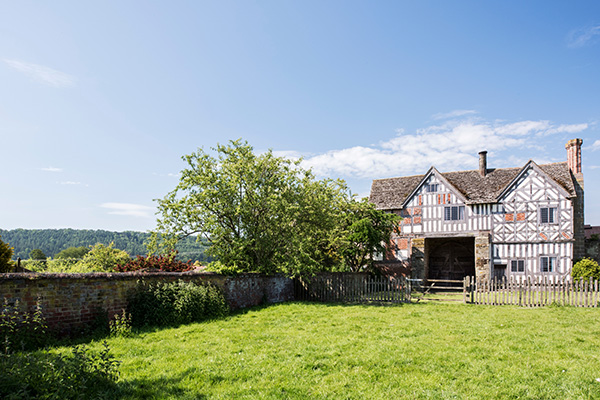
Once upon a time this gatehouse was a threshold, part of the fortified manor of the medieval family that gave their name to the neighbouring village of Acton Burnell. Then came the Lees. Under the new king James I in the early 1600s, like any self-respecting family rising steadily up the social ladder, they left their mark through a spot of home improvement. Now, after more than four hundred years, nothing remains of the low, rambling buildings of Langley Hall that their smart new gatehouse was supposed to guard. The manor turned into farmhouse by the eighteenth century, and crumbled to dust by the late nineteenth. But the sturdy Jacobean brick and stone and timber of the gatehouse persisted stubbornly.
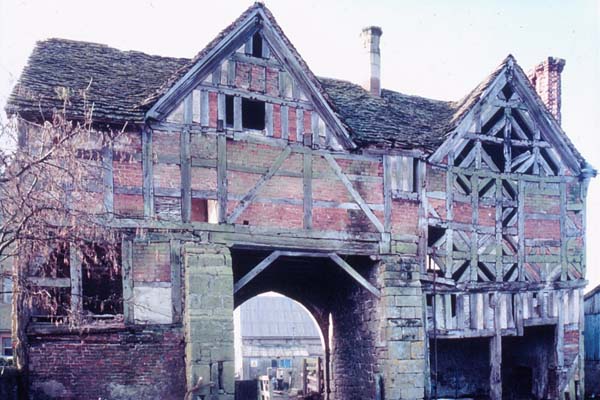 Langley Gatehouse before restoration
Langley Gatehouse before restoration
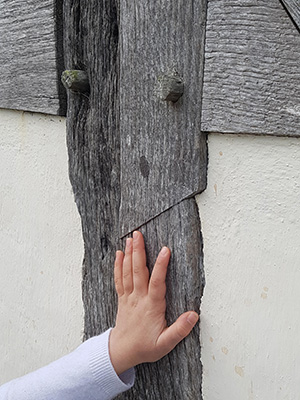 Later one evening, safely ensconced on the squashiest of armchairs in the living room, we look at an album full of old photographs of its restoration – a crooked, gap-toothed structure slowly fleshed out again into a habitable space and home. In the meantime, with a magpie’s eye for shiny new things, Small Child has collected a new word: Jacobean. King James I, lugubrious in the pack of historical Top Trumps cards, is scrutinised with renewed interest. The timber frame is originally Jacobean, and yes, the gables are Jacobean too, and so are the slates on the roof. No, the cooker definitely is not Jacobean, and neither is the fridge. Nooks and crannies are explored for treasure, and walls and woodwork inspected. The gatehouse is a threshold still. Little feet patter in and out of time across its lopsided oak floorboards throughout our stay.
Later one evening, safely ensconced on the squashiest of armchairs in the living room, we look at an album full of old photographs of its restoration – a crooked, gap-toothed structure slowly fleshed out again into a habitable space and home. In the meantime, with a magpie’s eye for shiny new things, Small Child has collected a new word: Jacobean. King James I, lugubrious in the pack of historical Top Trumps cards, is scrutinised with renewed interest. The timber frame is originally Jacobean, and yes, the gables are Jacobean too, and so are the slates on the roof. No, the cooker definitely is not Jacobean, and neither is the fridge. Nooks and crannies are explored for treasure, and walls and woodwork inspected. The gatehouse is a threshold still. Little feet patter in and out of time across its lopsided oak floorboards throughout our stay.
There is much to do. We catch up with friends around the kitchen table, and wave at the friendly dog-walker on the roadside as we set out on yet another trip. There are conversations with our neighbour the old farmer as Small Child eyes the feed he is serving to the lambs for breakfast. Little wisps of wool come floating over the fence in the morning breeze as they speak.
Over the last two years, as the pandemic squeezed and moulded our everyday lives into newly unfamiliar boundaries, I had been writing a book about Jacobean England and the earliest days of the East India Company. But I kept getting caught up in stories of ordinary English lives, and their tangled threads of marriages and friendships, chance meetings and links of obligation, forged over generations. Perhaps it was the enforced isolation that made me return to it so obsessively – a shimmering, nearly invisible network of everyday living and connections, tenuous and circumstantial, holding up the entire web of history, trade and adventuring, government and politics.
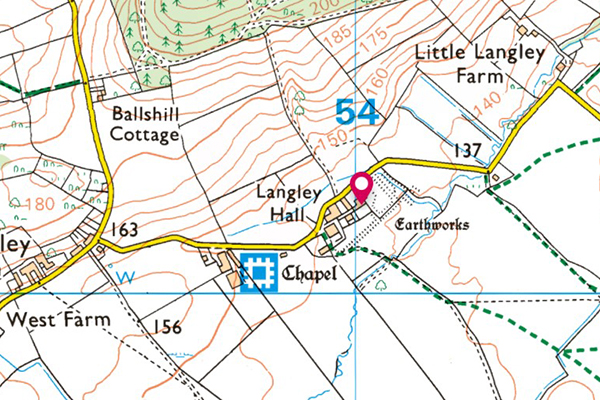
There is an invisible network of community and human contact that holds Langley together too, and its threads run across the past and the present. At the top of the instantly recognisable volcanic silhouette of the Wrekin that we can see out of one window, there was once an Iron Age hill fort and settlement. Past the village of Acton Burnell are the traces of a Roman road, superimposed on an even older thoroughfare. One afternoon we clamber across the furrows of the field next to the gatehouse to get to the spot where a chapel had stood since the fourteenth century. The current chapel, now restored, is a perfectly preserved Tudor time-capsule. For over four hundred years as monarchs changed and civil war raged, its rough wooden box pews and whitewashed walls, decorated with a smattering of Tudor roses and fleurs-de-lis, marked a space where manor lord and village folk, farmers and craftsmen, had been baptised and wedded, lost and mourned.
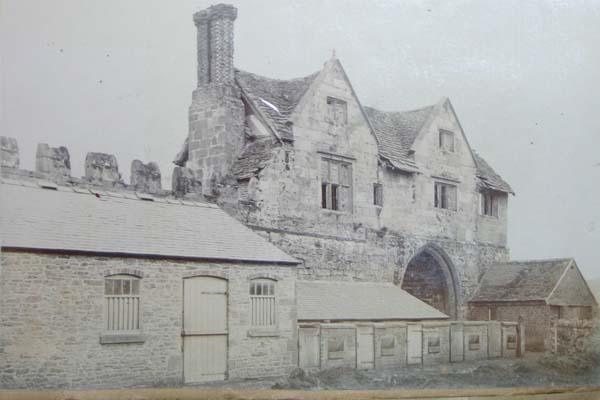 Langley Gatehouse from the SPAB archive
Langley Gatehouse from the SPAB archive
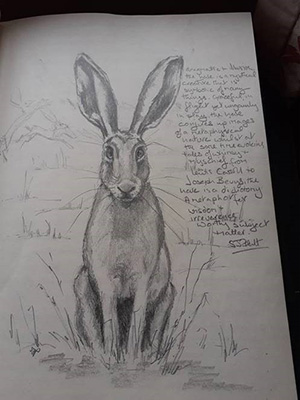 Inside the house, there are more recent conversations across space and time in the carefully preserved visitors’ logbooks. The volumes themselves look like they are determined to weather time long enough to keep the house company for the rest of its days. Their thick, creamy pages are full of handwritten notes of people who have stayed here before us. Moments are captured in their lines just as they are in every groove and hollow of the building itself: rain-soaked afternoons spent in front of the fire in the living room, bracing walks through the Shropshire countryside after indulgent autumn lunches, summer evenings and the sudden excitement of a bat that has lost its way and needs to be guided out through an open window. The entries speak to each other, offering news of closed pubs that have reopened, and footpaths that are overgrown – a community of people whose presence never overlapped within these walls, and yet form part of the same fabric.
Inside the house, there are more recent conversations across space and time in the carefully preserved visitors’ logbooks. The volumes themselves look like they are determined to weather time long enough to keep the house company for the rest of its days. Their thick, creamy pages are full of handwritten notes of people who have stayed here before us. Moments are captured in their lines just as they are in every groove and hollow of the building itself: rain-soaked afternoons spent in front of the fire in the living room, bracing walks through the Shropshire countryside after indulgent autumn lunches, summer evenings and the sudden excitement of a bat that has lost its way and needs to be guided out through an open window. The entries speak to each other, offering news of closed pubs that have reopened, and footpaths that are overgrown – a community of people whose presence never overlapped within these walls, and yet form part of the same fabric.
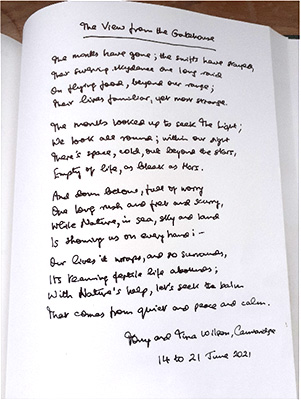 Small Child is delighted by the hand-drawn pictures that crop up every now and then. The scribbled unicorn is a hit, as is the living room where we are sitting, its cosy warmth reflected back to us in a quick pencil sketch. There are signatures of children, with careful records of single-digit ages to their nearest fraction, and hand-drawn paw prints of visiting pets. Korean and Mandarin and Bengali script shares space with English; the European and American guests tease the English ones about the strange national insistence on separate hot and cold taps, bracing walks in the rain, and tea.
Small Child is delighted by the hand-drawn pictures that crop up every now and then. The scribbled unicorn is a hit, as is the living room where we are sitting, its cosy warmth reflected back to us in a quick pencil sketch. There are signatures of children, with careful records of single-digit ages to their nearest fraction, and hand-drawn paw prints of visiting pets. Korean and Mandarin and Bengali script shares space with English; the European and American guests tease the English ones about the strange national insistence on separate hot and cold taps, bracing walks in the rain, and tea.
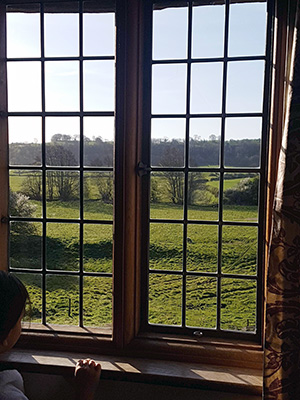 It is our last evening at Langley, and Small Child, assisted by long-suffering Teddy, is putting on a puppet show on the windowsill for the benefit of us within and the lambs outside. As her voice rings out, sweet and sharp and clear in the silence, it strikes me that the isolation of Langley is a different thing altogether from the new iterations of isolation, cold and claustrophobic, which we have all weathered in recent years as COVID-19 ravaged the world. At Langley, it is hard to ignore the signs of human presence and of communities continuing, surviving, transforming and being transformed. Its presence is an insistent reminder of the traces – at once fragile and tenacious – that we leave even in passing. Outside, the Shropshire sky is still light, a familiar novelty at this time of the year, at the threshold of seasons. Inside the gatehouse, the puppet show is still going on, and new stories are in the making.
It is our last evening at Langley, and Small Child, assisted by long-suffering Teddy, is putting on a puppet show on the windowsill for the benefit of us within and the lambs outside. As her voice rings out, sweet and sharp and clear in the silence, it strikes me that the isolation of Langley is a different thing altogether from the new iterations of isolation, cold and claustrophobic, which we have all weathered in recent years as COVID-19 ravaged the world. At Langley, it is hard to ignore the signs of human presence and of communities continuing, surviving, transforming and being transformed. Its presence is an insistent reminder of the traces – at once fragile and tenacious – that we leave even in passing. Outside, the Shropshire sky is still light, a familiar novelty at this time of the year, at the threshold of seasons. Inside the gatehouse, the puppet show is still going on, and new stories are in the making.
Book Langley Gatehouse from £18 per person per night, with plenty of availability this autumn and through 2023.
Find availability
With thanks to Nandini Das for sharing her blog with us.